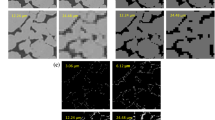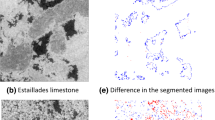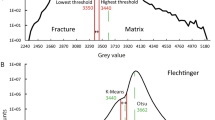Abstract
Accurate representation of pore space is essential for predicting fluid flow through subsurface porous media. Pore volume fraction, geometry, and topology determine transport characteristics at the pore scale and are used to make upscaled projections about reservoir behavior. X-ray computed tomography (XCT) allows for nondestructive 3D imaging of rock core samples and can therefore provide valuable information about the pore network in situ, but segmentation of XCT datasets into pore and mineral space is not trivial. In this study, three filters (contrast enhancement, noise reduction, and beam hardening correction) were applied to XCT datasets of rock core samples prior to training class definition for machine learning-based segmentation. Porosities derived from segmented datasets with and without filtering were compared and were validated with experimental values. XCT-derived porosity had reduced variance and was closer to experimental data when all three filters were applied. A case study of one rock core sample compared pore size distribution and simulated permeability to experimental data. Computational fluid dynamics simulations of flow through the pore network using OpenFOAM showed improved consistency in permeability values when all three filters had been applied. This suggests that the application of these filters prior to machine learning training class definition can improve the reproducibility of the segmentation results and reduce user bias, thereby increasing confidence in digitally derived rock parameters. Reliable initial porosity and permeability data are critical for improving fluid transport and fate projections in a broad range of subsurface systems.
Article Highlights
.
-
Filtered datasets were less affected by user bias in definition of training classes
-
Image filtering before segmentation improved consistency of simulated permeability
-
Image filtering improved reproducibility of digitally derived rock parameters









Similar content being viewed by others

Availability of data and material
The datasets generated and analyzed during the current study are available from the corresponding author upon request.
Code availability
The code used for this study is included in the Supplementary Information.
References
Alhammadi, A.M., AlRatrout, A., Bijeljic, B., Blunt, M.J.: Pore-scale imaging and characterization of hydrocarbon reservoir rock wettability at subsurface conditions using X-ray microtomography. JoVE 57915 (2018). https://doi.org/10.3791/57915
Arganda-Carreras, I., Kaynig, V., Rueden, C., Eliceiri, K.W., Schindelin, J., Cardona, A., Sebastian Seung, H.: Trainable Weka Segmentation: a machine learning tool for microscopy pixel classification. Bioinformatics 33, 2424–2426 (2017). https://doi.org/10.1093/bioinformatics/btx180
Bazaikin, Y., Gurevich, B., Iglauer, S., Khachkova, T., Kolyukhin, D., Lebedev, M., Lisitsa, V., Reshetova, G.: Effect of CT image size and resolution on the accuracy of rock property estimates. J. Geophys. Res. Solid Earth 122, 3635–3647 (2017). https://doi.org/10.1002/2016JB013575
Deng, H., Fitts, J.P., Peters, C.A.: Quantifying fracture geometry with X-ray tomography: Technique of Iterative Local Thresholding (TILT) for 3D image segmentation. Comput. Geosci. 20, 231–244 (2016). https://doi.org/10.1007/s10596-016-9560-9
Doube, M., Kłosowski, M.M., Arganda-Carreras, I., Cordelières, F.P., Dougherty, R.P., Jackson, J.S., Schmid, B., Hutchinson, J.R., Shefelbine, S.J.: BoneJ: Free and extensible bone image analysis in ImageJ. Bone 47, 1076–1079 (2010). https://doi.org/10.1016/j.bone.2010.08.023
Garfi, G., John, C.M., Berg, S., Krevor, S.: The sensitivity of estimates of multiphase fluid and solid properties of porous rocks to image processing. Transp. Porous Med. 131, 985–1005 (2020). https://doi.org/10.1007/s11242-019-01374-z
Hommel, J., Coltman, E., Class, H.: Porosity-permeability relations for evolving pore space: A review with a focus on (bio-)geochemically altered porous media. Transp. Porous Med. 124, 589–629 (2018). https://doi.org/10.1007/s11242-018-1086-2
Iassonov, P., Gebrenegus, T., Tuller, M.: Segmentation of X-ray computed tomography images of porous materials: A crucial step for characterization and quantitative analysis of pore structures. Water Resour. Res. 45 (2009). https://doi.org/10.1029/2009WR008087
Khan, F., Enzmann, F., Kersten, M.: Beam-hardening correction by a surface fitting and phase classification by a least square support vector machine approach for tomography images of geological samples. Solid Earth Discuss. 7, 3383–3408 (2015). https://doi.org/10.5194/sed-7-3383-2015
Leu, L., Berg, S., Enzmann, F., Armstrong, R.T., Kersten, M.: Fast X-ray micro-tomography of multiphase flow in Berea Sandstone: A sensitivity study on image processing. Transp. Porous Med. 105, 451–469 (2014). https://doi.org/10.1007/s11242-014-0378-4
Lindquist, W.B., Venkatarangan, A., Dunsmuir, J.: Wong, T: Pore and throat size distributions measured from synchrotron X-ray tomographic images of Fontainebleau sandstones. J. Geophys. Res. Solid Earth 105(B9), 21509–21527 (2000). https://doi.org/10.1029/2000JB900208
Lormand, C., Zellmer, G.F., Németh, K., Kilgour, G., Mead, S., Palmer, A.S., Sakamoto, N., Yurimoto, H., Moebis, A.: Weka Trainable Segmentation plugin in ImageJ: A semi-automatic tool applied to crystal size distributions of microlites in volcanic rocks. Microsc. Microanal. 24, 667–675 (2018). https://doi.org/10.1017/S1431927618015428
Ma, J.: Review of permeability evolution model for fractured porous media. J. Rock Mech. Geotech. Eng. 7, 351–357 (2015). https://doi.org/10.1016/j.jrmge.2014.12.003
Mostaghimi, P., Blunt, M.J., Bijeljic, B.: Computations of absolute permeability on micro-CT images. Math. Geosci. 45, 103–125 (2013). https://doi.org/10.1007/s11004-012-9431-4
Münch, B., Gasser, P., Holzer, L., Flatt, R.: FIB-nanotomography of particulate systems—Part II: Particle recognition and effect of boundary truncation. J. Am. Ceramic Soc. 89, 2586–2595 (2006). https://doi.org/10.1111/j.1551-2916.2006.01121.x
Müter, D., Pedersen, S., Sørensen, H.O., Feidenhans’l, R., Stipp, S.L.S.: Improved segmentation of X-ray tomography data from porous rocks using a dual filtering approach. Comput. Geosci. 49, 131–139 (2012). https://doi.org/10.1016/j.cageo.2012.06.024
Nimmo, J.R.: Porosity and pore size distribution. In: Hillel, D., Hatfield, J.L. (Eds.), Encyclopedia of Soils in the Environment, pp. 295–303. Elsevier (2004)
OpenFOAM. OpenCFD. https://www.openfoam.com/ (2019)
Pini, R., Madonna, C.: Moving across scales: a quantitative assessment of X-ray CT to measure the porosity of rocks. J. Porous Mater. 23, 325–338 (2016). https://doi.org/10.1007/s10934-015-0085-8
Schindelin, J., Arganda-Carreras, I., Frise, E., Kaynig, V., Longair, M., Pietzsch, T., Preibisch, S., Rueden, C., Saalfeld, S., Schmid, B., Tinevez, J.-Y., White, D.J., Hartenstein, V., Eliceiri, K., Tomancak, P., Cardona, A.: Fiji: an open-source platform for biological-image analysis. Nat. Methods 9, 676–682 (2012). https://doi.org/10.1038/nmeth.2019
Sell, K., Saenger, E.H., Falenty, A., Chaouachi, M., Haberthür, D., Enzmann, F., Kuhs, W.F., Kersten, M.: On the path to the digital rock physics of gas hydrate-bearing sediments – processing of in situ synchrotron-tomography data. Solid Earth 7, 1243–1258 (2016). https://doi.org/10.5194/se-7-1243-2016
Shulakova, V., Pervukhina, M., Müller, T.M., Lebedev, M., Mayo, S., Schmid, S., Golodoniuc, P., Bastos De Paula, O., Clennell, M.B., Gurevich, B.: Computational elastic up-scaling of sandstone on the basis of X-ray micro-tomographic images. Geophys Prospecting 61 (2), 287–301 (2012). https://doi.org/10.1111/j.1365-2478.2012.01082.x
Tomasi, C., Manduchi, R.: Bilateral filtering for gray and color images. In: Sixth International Conference on Computer Vision (IEEE Cat. No.98CH36271). Presented at the IEEE 6th International Conference on Computer Vision, Narosa Publishing House, Bombay, India, pp. 839–846 (1998). https://doi.org/10.1109/ICCV.1998.710815
Ushizima, D., Parkinson, D., Nico, P., Ajo-Franklin, J., MacDowell, A., Kocar, B., Bethel, W., Sethian, J.: Statistical segmentation and porosity quantification of 3D x-ray microtomography, in: Tescher, A.G. (Ed.). Presented at the SPIE Optical Engineering + Applications, San Diego, California, USA, pp. 813502 (2011). https://doi.org/10.1117/12.892809
Wildenschild, D., Sheppard, A.P.: X-ray imaging and analysis techniques for quantifying pore-scale structure and processes in subsurface porous medium systems. Adv. Water Resour. 51, 217–246 (2013). https://doi.org/10.1016/j.advwatres.2012.07.018
Zhang, D., Zhang, R., Chen, S., Soll, W.E.: Pore scale study of flow in porous media: Scale dependency, REV, and statistical REV. Geophysical Res. Letters 27(8), 1195–1198 (2000). https://doi.org/10.1029/1999GL011101
Acknowledgements
The authors would like to thank Zixian Wang for her assistance in gathering laboratory results and Eva Albalghiti and three anonymous reviewers for their valuable feedback. Laboratory support: this study includes data produced in the CTEES facility at University of Michigan, supported by the Department of Earth & Environmental Sciences and College of Literature, Science, and the Arts. Mercury intrusion porosimetry data were collected in the Nanotechnicum lab in the Biointerfaces Institute at the University of Michigan.
Funding
This material is based upon work supported by the National Science Foundation (CAREER Grant No. 1943726) and the Alfred P. Sloan Foundation (Grant No. 2020–12,466). Any opinions, findings, and conclusions or recommendations expressed in this material are those of the author(s) and do not necessarily reflect the views of the National Science Foundation. This research was also supported by the University of Michigan Energy Institute through an Undergraduate Research Opportunities Program fellowship.
Author information
Authors and Affiliations
Contributions
Ellen P. Thompson: Formal analysis, Writing—Original draft, Conceptualization. Kira Tomenchok: Methodology, Conceptualization. Tyler Olson: Investigation. Brian R. Ellis: Supervision, Writing—Review & Editing.
Corresponding author
Ethics declarations
Conflict of interest
The authors have no known financial or personal competing interests to declare.
Additional information
Publisher's Note
Springer Nature remains neutral with regard to jurisdictional claims in published maps and institutional affiliations.
Supplementary Information
Below is the link to the electronic supplementary material.
Supplementary file2 (MP4 11044 kb)
Supplementary file3 (MP4 7815 kb)
Supplementary file4 (MP4 6727 kb)
Rights and permissions
About this article
Cite this article
Thompson, E.P., Tomenchok, K., Olson, T. et al. Reducing User Bias in X-ray Computed Tomography-Derived Rock Parameters through Image Filtering. Transp Porous Med 140, 493–509 (2021). https://doi.org/10.1007/s11242-021-01690-3
Received:
Accepted:
Published:
Issue Date:
DOI: https://doi.org/10.1007/s11242-021-01690-3



